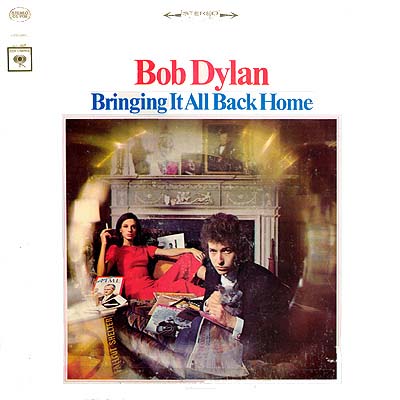
Once upon a time you dressed so fine, threw the bums a dime in your prime, didn't you?
1. Like a Rolling Stone (6:13)
2. Tombstone Blues (5:58)
3. It Takes a Lot to Laugh, it Takes a Train to Cry (4:09)
4. From a Buick 6 (3:19)
5. Ballad of a Thin Man (5:58)
6. Queen Jane Approximately (5:31)
7. Highway 61 Revisited (3:30)
8. Just Like Tom Thumb's Blues (5:31)
9. Desolation Row (11:21)
Review: Highway 61 Revisited is Bob Dylan's 6th studio album, arriving at the end of August in 1965. He had already released Bringing it All Back Home that year, the album that involved electric instrumentation for the first time in the young folk singer's career. Much has been written about Bob's decision to "go electric" in 1965. By the time Highway 61 Revisited came out, it seemed that Bob had left his acoustic folk roots more or less in the past. Every song is predominantly electric, with the exception of the epic closer Desolation Row.
But all that history is secondary to the jolt the listener receives the moment the album begins. The bold pop of a snare drum kicks off Like a Rolling Stone. What can be said about the song at this point? It was named the top song of all time by Rolling Stone Magazine. The song's lyrics appear to be directed at a former lover, Bob sneering "How does it feel? To be on your alone / a complete unknown / like a rolling stone." The song could just as well be interpreted as another goodbye to the folk establishment.
The album doesn't let up from there, moving to the upbeat guitar driven, surreal Tombstone Blues This tune contains the great line "The sun's not yellow, it's chicken." At 5:58, the song is just 15 seconds shorter than the famous opener.
The pace slows down for the bluesy It Takes a Lot to Laugh, it Takes a Train to Cry, then it quickens for From a Buick 6. These songs haven't gotten much live play from Bob, but Train especially is a nice relaxed number.
Ballad of a Thin Man makes things a bit spooky with its opening dark piano riff. Clocking in at around 6 minutes, it is another one of the heavyweights of the album. The song was famously directed towards an interviewer who Bob made very uncomfortable with his verbal jabs. Bob had grown tired of the media at this point, especially those who asked him questions without having the slightest idea (and maybe didn't even care) what they were talking about. It's a vicious vision of the reporter as an outsider, with the refrain "You know something's happening here but you don't know what it is."
The mood lightens a bit with the next track, Queen Jane Approximately. But the lyrics do not, at least some of them, possibly aimed at Joan Baez. Its one of the more underrated tracks in Bob's canon, with a world-weary theme that keeps returning to the a sneering Bob: "Won't you, come see me, Queen Jane."
The title track follows, an absurdist hard-rocking blues which doesn't have the impact it should due to an out-of-place clown whistle that opens the song and shows up, unwelcome, a few more times.
Another underrated song follows with the wonderful Just Like Tom Thumb's Blues. Now the song titles themselves are getting absurd! This is actually a fairly straight forward number, with a series as verses and no apparent chorus. The song closes with the narrator finally going back to New York City. The song was covered nicely by Neil Young in NYC at The 30th Anniversary Concert.
The album closer is one of Bob's first epics, the 11 minute apocalyptic Desolation Row. The song feels fuller than his earlier solo acoustic compositions on account of the additional lead acoustic guitar of Charlie McCoy - an interesting choice since the superb Michael Bloomfield played on the rest of the album. Still, McCoy is more than up to the task, filling in without taking over the song. Numerous literary characters make an appearance in the song, including Ezra Pound, T.S. Eliot, "Einstein disguised as Robin Hood," Cain and Abel, and many others. He later sings "All these people that you mention, yes I know them, they're quite lame." Bob bookends the album with 2 of his greatest songs ever.
Rating: 10/10 **********/**********
Best 3 Song Run: Highway 61 Revisited/Just Like Tom Thumb's Blues/Desolation Row (mostly for desolation Row)
Song I am most likely to skip: Highway 61 Revisited. That annoying siren - no contest.
Song Tiers: A+: Like A Rolling Stone, Desolation Row
A-: Queen Jane Approximately, Just Like Tom Thumb's Blues, Ballad of a Thin Man
B+: It Takes a Lot to Laugh, it Takes a Train to Cry
B: Tombstone Blues
B-: From a Buick 6, Highway 61 Revisited
Steven Sroczynski is an author and attorney from Massachusetts. He can be reached at steve.sroczynski@gmail.com
Copyright 2015 by Steven Sroczynski. All rights reserved. This blog, or any portion of it, may not be reproduced without the express written consent of its author, Steven Sroczynski.
